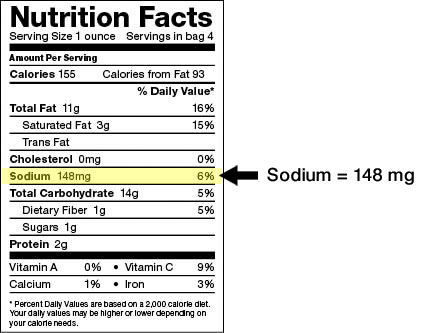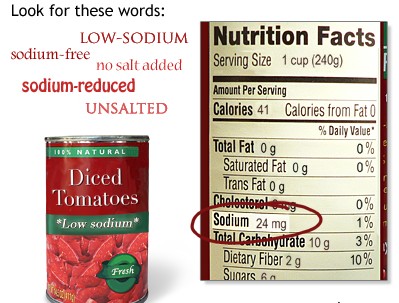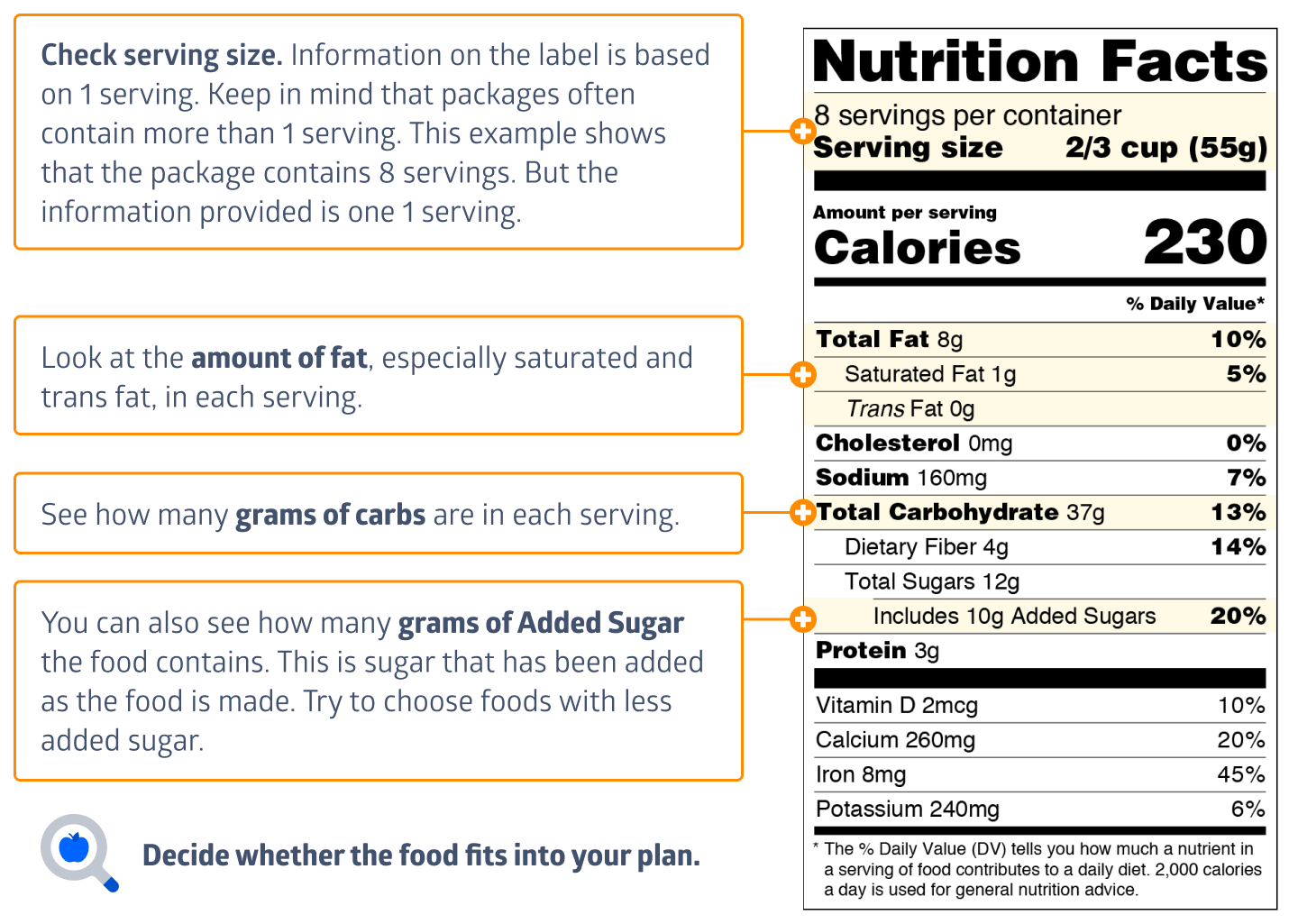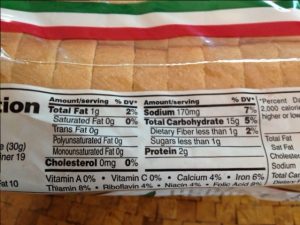42 reading sodium on food labels
Reading Labels - World Action on Salt & Health Some food labels may only state the sodium content. To convert sodium to salt, you need to multiply the amount by 2.5. For example, 1g of sodium per 100g = 2.5 grams of salt per 100g You then need to know the weight of the serving portion in grams e.g. 30g Then divide the concentration of salt per 100g by 100 and multiply by the serving size. PDF Controlling Sodium and Reading Labels - Veterans Affairs 2) Check sodium content. Use food labels and packaging to help you select the lowest sodium option. If unable to buy low sodium versions, drain and rinse canned foods under running water to remove excess sodium. • Choose foods with 140 mg sodium or less per serving. • Avoid food with more than 300 mg of sodium per serving.
How to Read Labels for a Low Sodium Diet - Salt Sanity Sodium nitrate is used to cure meats so you'll likely find it on labels of foods like lunch meat, bacon, and hot dogs. Research indicates sodium nitrate can damage arteries, causing them to harden and narrow, a potentially dangerous situation for patients with heart disease. There are some high sodium ingredients you will recognize.

Reading sodium on food labels
Sodium: How to Read Food Labels - Intermountain Healthcare 660 milligrams of sodium per serving — your actual percentage of sodium would be 33%, slightly higher than listed. Sodium is listed in milligrams. A food low in sodium should have about 140 milligrams or less per serving. The ingredients list will show you every ingredient in the product. The higher an ingredient appears on the list, How do you read a food label for salt / sodium? - Irish Kidney Diet Sodium x 2.5 = salt content or Salt ÷ 2.5 = sodium content. If you have kidney disease a good goal for sodium intake is 2300 mg of sodium or 6g salt per day. Check with your Doctor or Kidney (Renal) Dietitian to confirm what your maximum daily salt (sodium) limit should be. Nutrition information may be presented in two ways. PDF Read the Nutrition Facts Label for Sodium! - NHLBI, NIH Sodium 125mg 5% Total Carbohydrate 9g 3% Dietary Fiber 3g 12% Sugars 4g Protein 2g Vitamin A 35% • Vitamin C 6% Calcium 2% • Iron 2% Read the Nutrition Facts Label for Sodium! Nutrition Facts labels tell you what you need to know about choosing foods that are lower in sodium. Here is a Nutrition Facts label for frozen peas and carrots ...
Reading sodium on food labels. How to Understand and Use the Nutrition Facts Label | FDA Nutrients to get less of: Saturated Fat, Sodium, and Added Sugars. Saturated fat, sodium, and added sugars are nutrients listed on the label that may be associated with adverse health effects - and... How to Read Sodium Percentages on Food Packages - SF Gate A "very low sodium" product must have less than 35 milligrams of sodium, while a "low sodium" product must have less than 140 milligrams of sodium. All in the Name Along with reading the food... Food Labels | CDC If you eat the whole thing, you are eating 8 times the amount of calories, carbs, fat, etc., shown on the label. Total Carbohydrate shows you types of carbs in the food, including sugar and fiber. Choose foods with more fiber, vitamins, and minerals. Choose foods with lower calories, saturated fat, sodium, and added sugars. How to Read Salt Labels | Cooking Light When food companies make sodium claims, they have to follow labeling rules. For the consumer, the tricky part is that there are four claims. Two apply when a company is comparing their food to a loosely defined fully salted version. One refers to a specific sodium level, another to whether salt has been added.
What Sodium Labels Mean: A Guide to Decoding Sodium Labels On the back of a product, you'll find the nutrition label which will list the percentage daily value (or %DV) of sodium found in one serving. Be aware that the %DV is based on the upper recommended limit of daily sodium, or 2,400mg. Remember to Check the Serving Size Reading Food Labels - What You Need to Know - Drugs.com "Low sodium": One-hundred forty (140) mg or less per serving. "Very low sodium": Thirty-five (35) mg or less per serving. "Reduced" or "less" sodium: At least 25 percent less sodium per serving. Health Claims: Food labels may have a message that tells how a food or part of a food affects a disease or a health condition. The United States Food ... Understanding Food Nutrition Labels | American Heart Association If you want to consume less of a nutrient (such as saturated fat or sodium), choose foods with a lower % DV (5 percent or less). If you want to consume more of a nutrient (such as fiber), choose foods with a higher % DV (20 percent or more). Here are more tips for getting as much health information as possible from the Nutrition Facts label: How To Read Food and Beverage Labels | National Institute on Aging At the top of the Nutrition Facts label, you will find the total number of servings in the container and the food or beverage's serving size. The serving size on the label is based on the amount of food that people may typically eat at one time and is not a recommendation of how much to eat. Read more about serving and portion sizes.
How to Read a Food Label to Limit Sodium: Care Instructions The label lists the ingredients in a food in descending order (from the most to the least). If salt or sodium is high on the list, there may be a lot of sodium in the food. Know that sodium has different names. Sodium is also called monosodium glutamate (MSG), sodium citrate, sodium alginate, and sodium phosphate. Read Nutrition Facts tables PDF Reading Food Labels to Look for Sodium Easy-to-read food labels can help you find foods low in sodium. This will help you keep track of the number of grams (g) or milligrams (mg) you consume each day. According to Food and Drug Administration regula- tions, no manufacturer can say that their product is "low-sodium" unless they can prove that claim. Label reading 101 - Healthy Food Guide Label reading cheat sheet For any packaged food product you choose, the health guidelines to aim for are: Less than 10g fat per 100g Less than 15g sugar per 100g Less than 120mg sodium per 100g What about the Health Star Rating? This Australian government health initiative ranks products on a scale from half a star to five stars. Food Labels: Read It Before You Eat It! - AAAAI For example, sodium caseinate can be used to indicate that a product contains a milk protein called casein. Therefore, when reading a food label, start with the "contains" statement.
What Should I Look for When I Read Nutrition Labels? Here's your quick list to determine if the label you're reading passes the PLANTSTRONG sniff test. 1) Sodium: Your recommended total daily intake should be around 1500-2000mg daily so when reading a label, you want the number of calories per serving to be equal to or lesser than the number of milligrams of sodium per serving. (For example ...
How to Read a Food Label to Limit Sodium: Care Instructions On most foods, there is a Nutrition Facts label. This will tell you how much sodium is in one serving of food. Look at both the serving size and the sodium amount. The serving size is located at the top of the label, usually right under the "Nutrition Facts" title. The amount of sodium is given in the list under the title.
How to Read a Nutrition Label: Common Supplement Facts Terms to Know You can keep your sodium levels under control by checking the nutrition label to be sure that snack foods contain under 300 milligrams of sodium and meals contain less than 700 milligrams per serving.
How to Read Food Labels | mySugr Reading food labels gives you a better understanding of what's in your food — making it easier to make healthy choices. ... Look at the total grams of carbs and calories listed on the food label, too. Don't Forget Sodium. Sodium, or salt, doesn't affect blood sugar. But, eating too much salt increases your risk of heart disease and high ...
Sodium on the Nutrition Facts Label | FDA Most Americans eat too much sodium and diets higher in sodium are associated with an increased risk of developing high blood pressure. The Nutrition Facts label is a handy tool you can use every...
How to understand food labels - Eat For Health The Nutrition Information Panel on a food label offers the simplest and easiest way to choose foods with less saturated fat, salt (sodium), added sugars and kilojoules, and more fibre. It can also be used to decide how large one serve of a food group choice or discretionary food would be and whether it's worth the kilojoules.
Reading Food Nutrition Labels 101 and How to Decode Them Limit the high sodium foods you eat, aiming for a daily intake of 2400 milligrams or less. Sodium-free - less than 5 milligrams per serving Low sodium - 140 milligrams or less per serving Reduced sodium - at least 25% less sodium than the original version Carbohydrates and Protein Content Carbohydrates have their own special listings as well.
How to Decode Salt on Food Labels: Low Sodium vs Reduced Sodium vs ... These foods have at least 25% less sodium than their original version. "Light in sodium" or "lightly salted" items are reduced by 50%. Unlike low sodium foods, reduced sodium foods can still be swimming in sodium. (One reduced-sodium soup we saw packs 660 mg per serving!) Keep an eye out for reduced sodium soups, reduced sodium chicken ...
Sodium and Food Labels | Sutter Health It's important to note that all nutritional labels list amounts of nutrients per serving. This item, for example, lists 16 servings in the entire container. The sodium level is 120 mg for one serving. That means if you drink the entire container, you'll get 1,920 mg sodium! That could be a critical error if you're not careful.
PDF A Guide to Reading Food Labels - University of Rochester A Guide to Reading Food Labels Reading food labels can help you make wise food choices. Most foods list nutrition ... Americans typically eat too much saturated fat, trans fat, cholesterol, and sodium, which can increase the risk for heart disease, cancer or diabetes. Total fat is important to watch, but saturated fat and trans fat are
PDF How Do I Understand the "Nutrition Facts" Label? Nutrition Facts label and ingredient list. When you go grocery shopping, take time to read the Nutrition Facts labels on the foods you purchase. Compare the nutrients and calories in one food to those in another. The information may surprise you. Make sure you aren't buying foods high in calories, saturated fat, trans fat, sodium and added ...
PDF Read the Nutrition Facts Label for Sodium! - NHLBI, NIH Sodium 125mg 5% Total Carbohydrate 9g 3% Dietary Fiber 3g 12% Sugars 4g Protein 2g Vitamin A 35% • Vitamin C 6% Calcium 2% • Iron 2% Read the Nutrition Facts Label for Sodium! Nutrition Facts labels tell you what you need to know about choosing foods that are lower in sodium. Here is a Nutrition Facts label for frozen peas and carrots ...
How do you read a food label for salt / sodium? - Irish Kidney Diet Sodium x 2.5 = salt content or Salt ÷ 2.5 = sodium content. If you have kidney disease a good goal for sodium intake is 2300 mg of sodium or 6g salt per day. Check with your Doctor or Kidney (Renal) Dietitian to confirm what your maximum daily salt (sodium) limit should be. Nutrition information may be presented in two ways.
Sodium: How to Read Food Labels - Intermountain Healthcare 660 milligrams of sodium per serving — your actual percentage of sodium would be 33%, slightly higher than listed. Sodium is listed in milligrams. A food low in sodium should have about 140 milligrams or less per serving. The ingredients list will show you every ingredient in the product. The higher an ingredient appears on the list,











Post a Comment for "42 reading sodium on food labels"